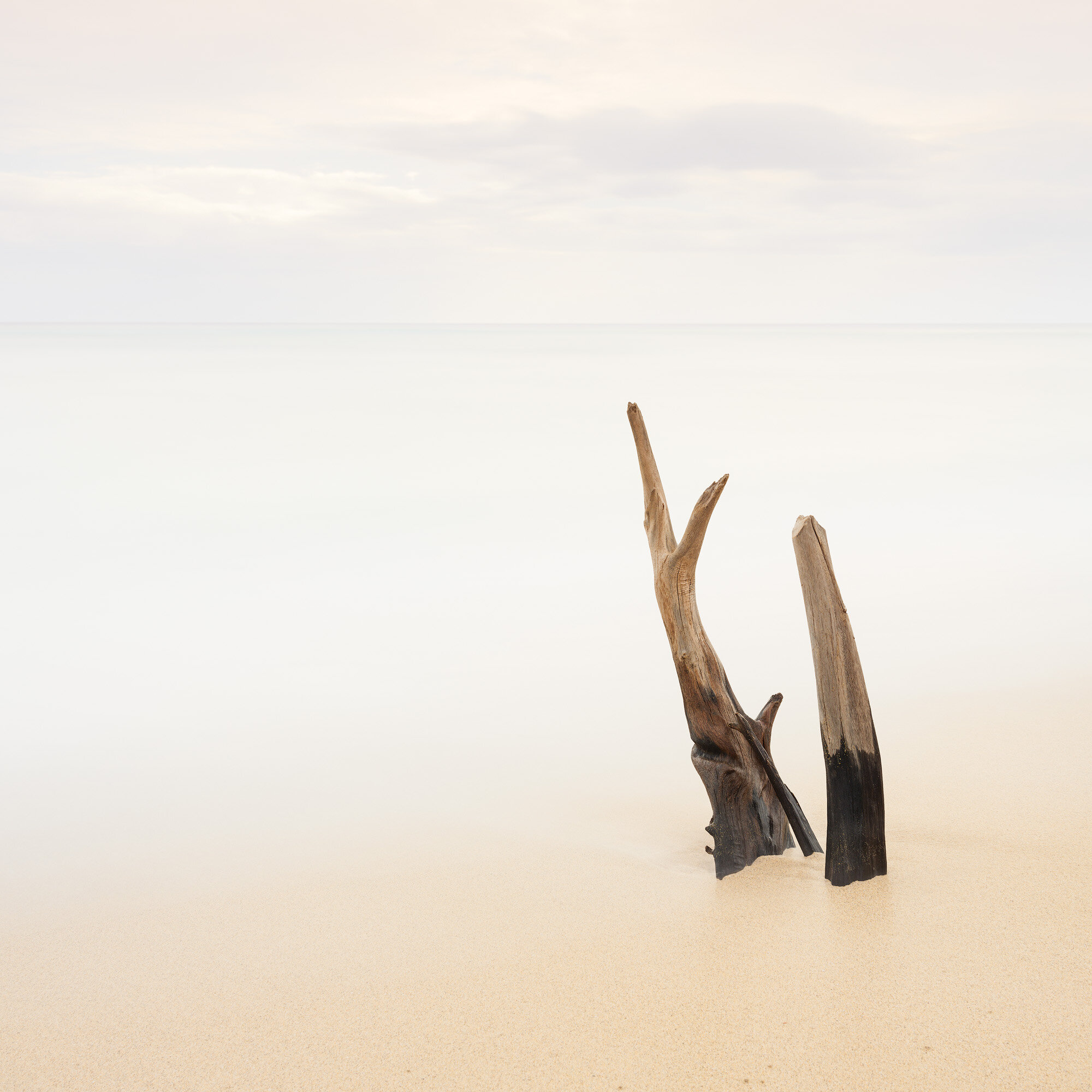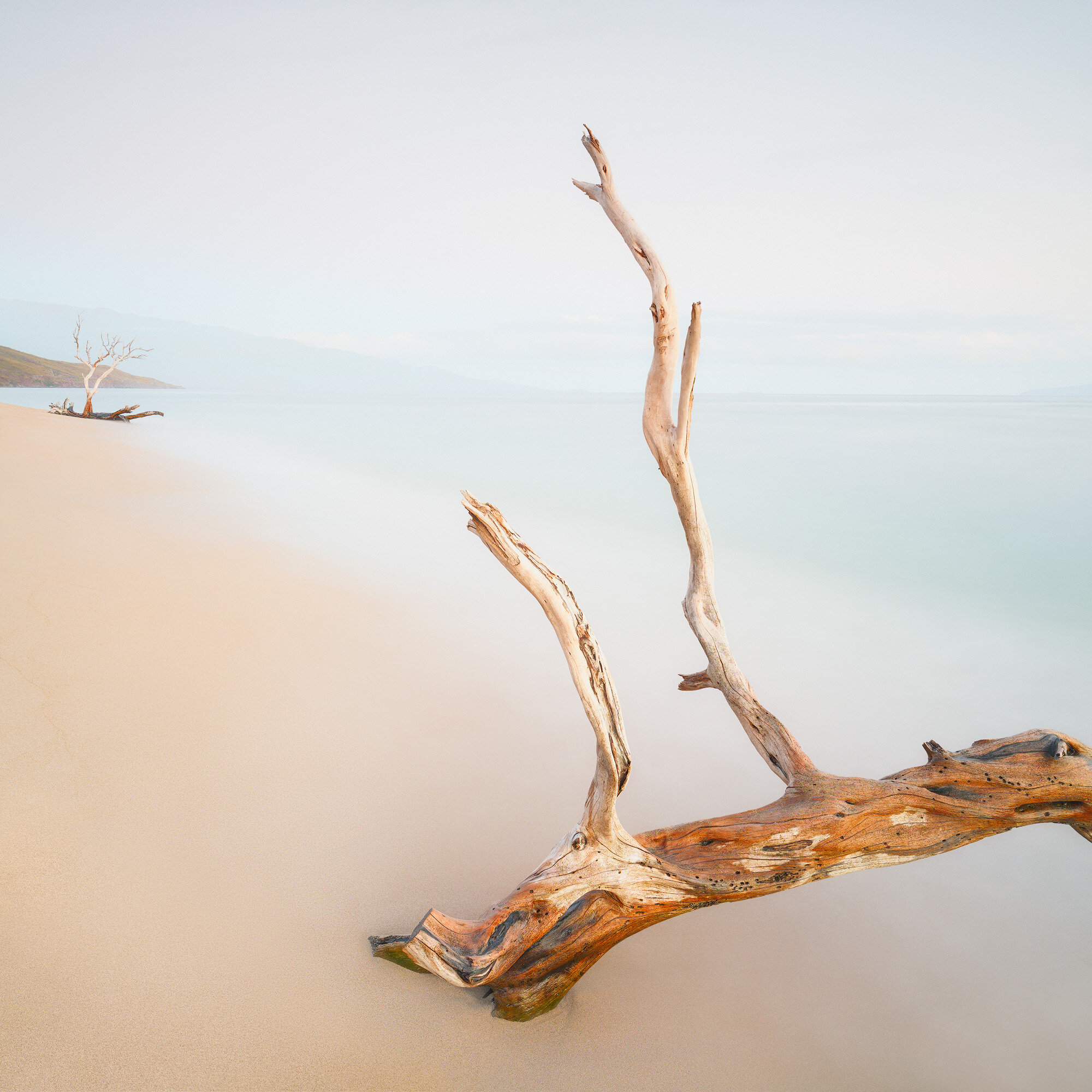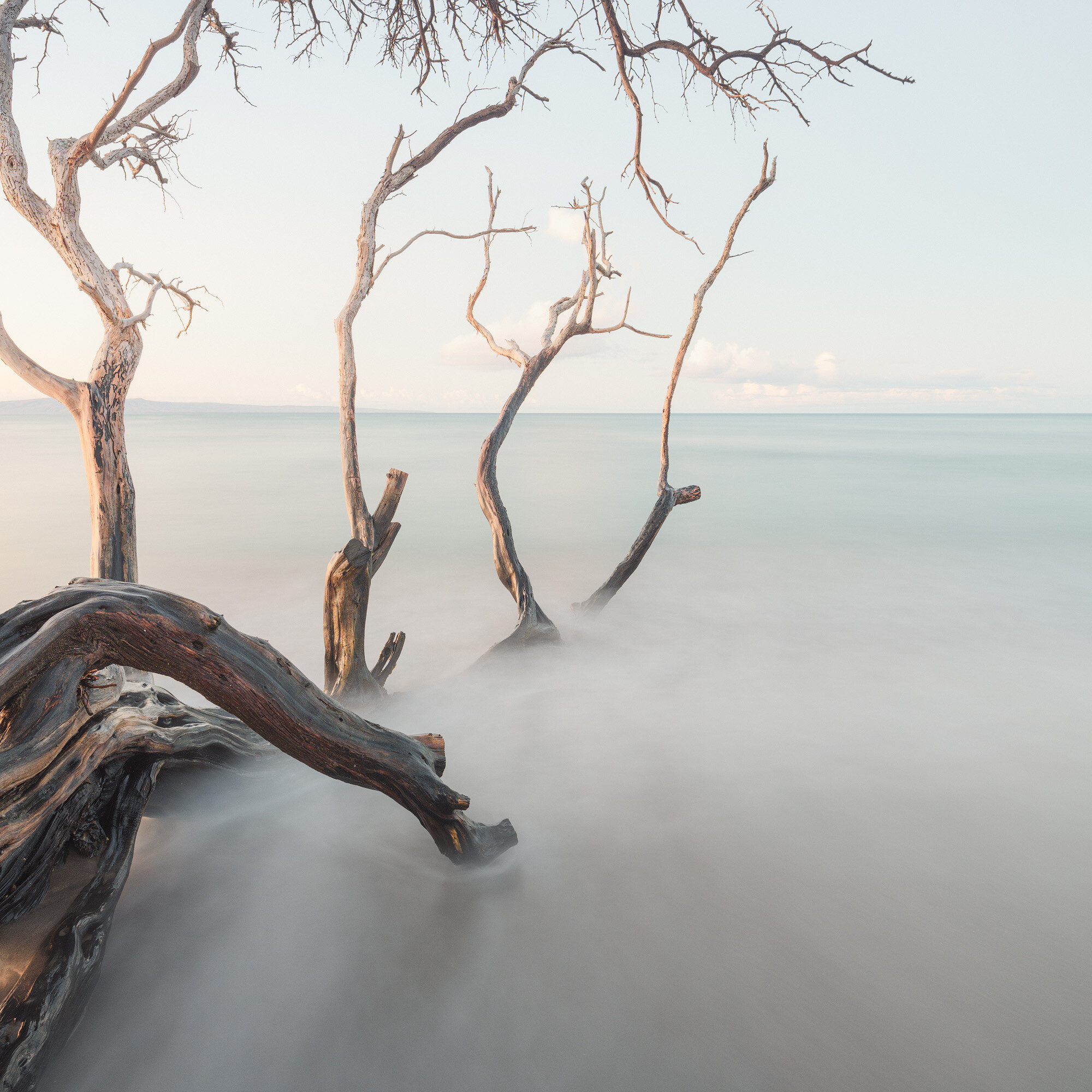kiawe: A FRESH PERSPECTIVE
Ukumehame Beach is a small strip of sand on Maui’s west side. It has all the necessities of a good beach – soft sand, clear waters and a few special features to draw a photographer’s eye. It’s the kind of place that tourists overlook, which makes it all the more attractive to us locals.
I’ve been photographing the Ukumehame coastal area my entire photographic career. When I first started, the shore was abundantly lined with skeletal Kiawe trees that the camera loved. It was there among those trees that I made my first dynamic long-exposure photograph nearly two decades ago.
The sun had set and the light levels were quite low, almost dark. But I wasn’t ready to pack up my old-school mechanical panoramic film camera – a Linhof 617 Technorama – and head home. After all, I still had a couple of frames of Fuji Velvia loaded and ready to go.
The spot meter read the scene for four minutes, and though at that time I didn’t know why a photographer might want to shoot a four-minute-long exposure, I trusted the meter.
A week later, I got the processed film back from developing and was thrilled to see a stunningly peaceful rendition of sturdy Kiawe trees proudly looking out at the soft, blurred tides.
To this day, that image represents an important step in my photographic journey. It started me on my long-exposure path and helped shape the still-water look that has become a signature of my work.
Almost all of the trees featured in that first image have been gone for years now, taken out one-by-one by big winter storms, and swept out to sea. There is only one Kiawe tree remaining along that stretch of beach that remains photogenic and that I continue to photograph. I have shot it literally hundreds of times, quite often using the same composition.
I learned years ago how important it is to shoot the same subject and location over and over again.
The practice teaches a photographer how to form deeper relationships with the subject, and better understand how the primary subject interacts with secondary elements – like the way high tide may introduce a new stunning reflection, or how a blaze of stars in a dark sky might be the missing element that lifts the image to new heights.
Revisiting a subject also serves as valuable “practice”. You can not develop your skills in anything without a healthy (or obsessive) amount of practice. It always surprises me to hear aspiring photographers think that they can simply photograph their two-week vacations once or twice a year and come home with compelling imagery! It doesn’t work that way.
Long-form study of a subject will inform the direction of your photography, help to narrow your vision, teach you to deepen your expression and make your communication more concise and clear.
Of course, this long-form study isn’t without its challenges. Without a positive mindset and a curious eye, it’s easy to get stuck in a rut.
Like any long-term relationship, it’s easy to get set in our ways over time. We can become too narrowly focused on certain traits that initially appealed to us, and may not notice how the subject has changed and evolved, or how we have changed and evolved.
I still love photographing that last, lone Kiawe tree on Ukumehame beach, but for quite some time, I have allowed my composition of it to default to the same way I have photographed it countless times before. My seeing of the area was partly obscured beneath a negative sense that the best years of the location were in the past. My curious eye stopped looking for new possibilities.
THE ENDLESS KNOT
Sometimes we become mindful of our creative ruts and make a change. Other times, life gives us an experience that forces a shift of perspective.
This year, I experienced a heavy shift in life when my father unexpectedly passed away. Amid that sudden loss, I found myself compelled to work in a space that felt safe and comfortable and close to home, and with a subject that I knew like a longtime childhood friend. I spent many evenings wandering the shores of Ukumehame – camera in hand, dad on my mind.
As the days rolled on, these contemplative outings introduced a fresh creative flow in me. Suddenly, I was seeing familiar subjects in ways I had not for many years.
I was drawn, again and again, to the swirling thorny branches and last rooted remains of the Kiawe trees littering the coast. Perhaps it was because in some vague way I was trying to make a connection to my father – he was tough and proud like this hardy species of tree. But more likely, it was a symptom of a greater perspective change.
In every aspect of life, there is Form and there is Space. In photography, Form refers to the subjects and shapes, while Space is everything in between. Internally, Form is represented in our thoughts and emotions, while Space is the stillness that surrounds them.
Finding a balance between Space and Form is an important practice both personally and artistically. We tend to focus too much of our attention on the Forms of the world. We take pictures of a subject without giving any thought to the Space around it, and we fixate on one emotion or thought, without any notice to the vast stillness it resides in.
I had been restricted for years by the mindset that I had shot Ukumehame to death – that there was nothing more to capture in the area apart from variations of the same old compositions. The Forms of the Kiawe trees had become so commonplace in my life that I lost sight of the Space that completed them.
But as I began the practice of balancing the Form of my grief by bringing greater attention to the Space around it, I found balance in my photography as well.
It would be easy to say that the jarring life event of my father passing was the key to unblocking my creative flow, but that’s not the answer.
I wasn’t reinvigorated by losing my dad, but in the time spent meditating on Space that followed: the Space around the grief, and the Space around the trees.
Inspiration is rarely, if ever, an external force. It comes from within, which means we are never without the power to meet it. We must only get in touch with gratitude and a positive mindset.
Gratitude is the practice of accepting what is in any given moment and observing it without judgement. When you approach a space without desiring for it to change, you are given the power to choose your mindset within that space.
Positive results follow a positive mindset. You can choose to view the world around you through a positive outlook – connecting with Space in a way that will allow for more creative energy and innovation. That is a big deal for artists.
It means we have unlimited potential. It means we can photograph the same subject again and again over the course of our entire lives and still have more to learn from it. Why? Because Space is infinite. And because the Form of every subject resides in that limitless Space, it can be captured in endless ways.
Space is what makes long-form study both possible and beneficial – and the knowledge of it will graciously seep into every aspect of our lives if we allow it.
It’s my belief that my dad is still present in my life, but now it is not for us to meet in the Forms of the world. And though I miss his long, rambling phone calls and blossoming tender spirit, I am grateful for the knowledge that I can meet him in the Infinite Space where washed-away Kiawe trees and true lasting wonder exist.







